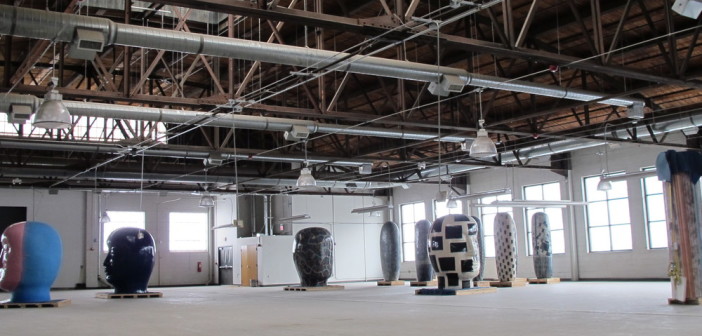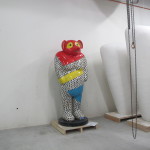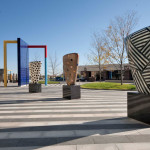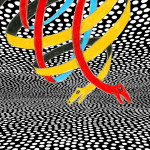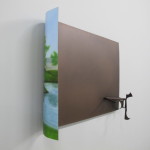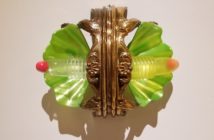There's a neighborhood near Omaha's Old Market known locally as "the Kaneko zipcode." If you've never heard the name Jun Kaneko—as was the case for me until last week—pay closer attention to the wall tiles in Boston's Aquarium T Station. Kaneko installed the ceramic mural, titled "Currents", as part of the MBTA's Public Art in Transit program. But other than through its medium, this piece is only dimly representative of an artist whose signature work remains gigantic ceramic heads and rows of colorfully glazed and patterned dangos.
To an outsider repeatedly hearing the name "Kaneko" mentioned in different contexts, it could almost be a verb—to kaneko—or maybe an adjective—that's really kaneko. The confusion stems from the hybrid nature of the artist's practice that has now turned into a creative brand: Kaneko has grown beyond the single man into a sort of institute offering "open space for your mind."
As an individual, Jun Kaneko creates large sculptural works, paintings, even opera sets. His special projects combine mural work, site-design and landscape architecture, with the over-sized sculptures. Upcoming: an installation of Tanukis in Chicago's Millennium Park, home to Kapoor's Cloud Gate. These raccoon dogs are known in Japanese folklore as mischievous shape-shifters—not unlike the coyote in Native American culture. Like the dangos and heads, Kaneko and his assistants build them out of large clay slabs and fire them whole in an enormous kiln for up to 12 days. Each 7 foot Tanuki is individually hand-painted. The construction and drying process is fascinating to observe, and, whether you are partial to this type of sculpture or not, the final glazes make the pieces far more textured and painterly close up than is noticeable at first glance. Jun Kaneko is successful. Today, his studios, offices and storage take up a whole building and a former high-school downtown and, various projects combined, employ about two dozen people. Younger artists working with ceramics got their start working for Jun, sometimes like Jess Benjamin as "kiln sleepers."
The Kaneko story is an interesting case of artist turned patron. Jun and his wife Ree Kaneko (née Schonlau) were two of the four founders of the Bemis Center for Contemporary Art. Launched in 1981, it is home to a now renowned artist residency and exhibition space. A 2009 capital campaign raised $2.6 million for an expansion of the live/work studios, a 2,000 sq. ft. multipurpose space and the renovation of the 10,000 sq. ft. Okada Center for Sculpture and Ceramics. Yes, there is money in Omaha— home to Warren Buffett and five Fortune 500 companies—but locals also take pride in their cultural groups and individuals, and aren't shy in stepping forward to offer support.
Since leaving her job as Executive Director of the Bemis in 2001, Ree has devoted her energy to KANEKO, the non-profit. KANEKO positions itself as "a new kind of organization", neither exactly museum, nor gallery, nor library, nor research center, but a flexible venue that combines all these attributes. KANEKO hosts Big Omaha, the city's equivalent to TED Talks, making it a hub of creative entrepreneurship. Concerts, performances, exhibits, lectures, artist presentations, workshops, and conferences take place within its walls. Some projects are only just starting up like Discuss Creativity, an online forum launched to build community virtually, or KANEKO-UNO, a physical "Creativity Library."

KANEKO's future: expansion plans designed by Mark Mack with a Jun Kaneko gray and black granite pavement.
One can scoff at what looks like an empire, but the truth is that it sometimes takes visionary leaders to build up these kinds of ambitious community outreach programs, educational and creative structures. Who really cares that Jun Kaneko's work is on display throughout: it's a space for creativity started by an artist. KANEKO's goal is to put Omaha on the map, and while most people still consider Nebraska a fly-over state, I for one will be applying to the Bemis. Did I mention they pay?
- Kaneko: the new studio photo: Stephanie Cardon
- Jun Kaneko. A Tanuki in fabrication. photo: Stephanie Cardon
- Jun Kaneko, Mid-America Center, Council Bluffs, 2008 Hand-built glazed ceramics, cast bronze, steel, granite Photo courtesy of www.junkaneko.com
- Jun Kaneko, Poster for the production of Mozart’s Magic Flute designed for the San Francisco Opera. 2011-2012 Digital print on paper Image courtesy of www.junkaneko.com
- Nate Boyce at the Bemis photo: Stephanie Cardon
- Nate Boyce at the Bemis photo: Stephanie Cardon

